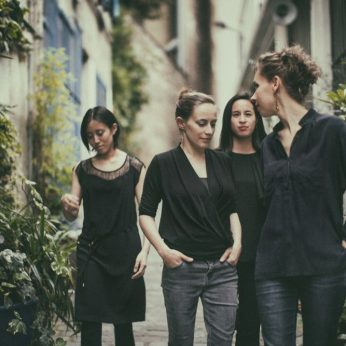Composer: Ludwig van Beethoven (b. 1770 - d. 1827)
Performance date: 26/06/2023
Venue: Bantry House
Composition Year: 1826
Duration: 00:27:25
Recording Engineer: Tom Norton
Instrumentation: 2vn, va, vc
Instrumentation Category:String Quartet
Artists:
Ardeo Quartet (Carole Petitdemange, Mi-Sa Yang [violins] Yuko Hara [viola], Joëlle Martinez [cello]) -
[String Quartet]

Ludwig van Beethoven [1770-1827]
Quartet No.16 in F major Op.135 [1826]
1. Allegretto
2. Vivace
3. Lento assai, cantate e tranquillo
4. Der schwer gefasste Entscluss – Grave, ma non troppo tratto – Allegro
The last works of great artists have always inspired a certain reverence, entirely appropriate in the case of, say, Bach’s Art of Fugue or Schubert’s C major Quintet, but how can we be reverential in the face of Beethoven’s last quartet? It has been tried – there is a remarkable and famous recording by the Busch Quartet where they add three minutes to the magical slow movement dragging the sweet song of rest prematurely into the cemetery. Beethoven had just written four monumental quartets, each one composed on the back of the previous one and each one more complex and difficult than its predecessor, so it is hard not to feel that Beethoven is indulging his anarchic sense of humour in this witty and delightful work that, in many ways, feels like a homage to his old teacher Haydn. And we must remember that, when Beethoven was writing this work, he had no reason to believe that his final illness was only two months away. After he completed this quartet he moved straight on to the replacement finale for Op.130, which also harks back to the eighteenth century. He then began a string quintet in C major, which was still on his desk when he died. Legend has it that Schubert, who was one of Beethoven’s pallbearers, got his inspiration for his quintet from hearing about Beethoven’s incomplete score.
The first movement revives a well-worn Beethoven device, the question and answer session. The viola asks the question, immediately answered by the first violin: the viola repeats the question, this time decisively, if not rudely, answered by both violins. These motives now become part of the witty debate that follows along with the lilting first theme, while the mood remains light-hearted and seemingly carefree. When Beethoven was still writing this work, he went to stay with his brother at Gneixendorf in the country some distance from Vienna. The early autumn weather was idyllic and he resumed his customary habit of composing outside, humming and waving his arms, to the bewilderment and amusement of the locals. The Scherzo and its boisterous Trio fit wonderfully into this slightly mad but good-natured scenario. The main theme is quite simple but the delightful syncopation gives a special charm along with the typically gruff interruptions. The Trio reminds one of the story of the pianist playing a Beethoven sonata and getting stuck inside a repeat, unable to find the password that will let him out, condemned to go endlessly round and round. Here we end up with the first fiddle see-sawing over a persistently repeated quaver accompaniment group that seems unable to stop.
The mood changes for the slow movement in that dramatic manner so typical of late Beethoven. This is a stunningly beautiful Lento in D flat, the still point around which this work revolves. The music unfolds slowly like the petals of a rose until, at the centre we find the worm in the bud – questioning and conflict in a ten-bar più lento in which the theme is brutally dismembered. Finally the petals of the theme fold in again leaving the questions unanswered.
The last movement has a whole story all to itself. After the premiere of the Op.130 quartet by the famous Schuppanzigh Quartet, a well-known and opulent musical amateur boasted that he could arrange for a better performance in his own house and that he could easily get the manuscript parts from Beethoven. However when he approached Beethoven through intermediaries, Beethoven insisted he pay Schuppanzigh fifty florins for the privilege of using the parts. The horrified musician asked whether it must be, to which Beethoven, intrigued by the philosophical implications, delightedly responded with the canon Es muss sein (It must be! Yes yes yes yes! Out with your wallet!). For this finale Beethoven now inverts his Es muss sein theme to ask the question Muss es sein? and turns it into the opening phrase of the slow introduction, which he jokingly entitles The Difficult Decision. But our laughter is immediately stifled when we are confronted by those ferocious chords in the fifth and following bars that so clearly echo the outcry at the heart of the slow movement. The music that follows seems like the laughter of the Gods as they turn the questions that mortals ask into a sublime and joyful dance. But Beethoven is not finished with his question and the Grave ma non trotto tratto (Serious but not too drawn out) introduction returns at the end of the development in a new and trembling version. At the very end the question is asked once more, whereupon Beethoven responds with an impudent pizzicato version of the second subject and a mocking violin obbligato.
Francis Humphrys
Copyright © 2025 West Cork Music. All rights reserved.
Designed and developed by Matrix Internet